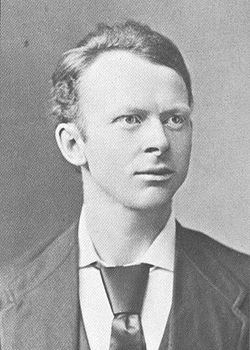- Charles Fillmore (Unity Church)
-
Part of a series on related to
New ThoughtMovementHistory • Discrimination • Criticism
Glossary • Literature - Atom-Smashing Power of Mind (1949)
- Christian Healing
- Dynamics for Living
- Jesus Christ Heals (1936)
- Keep a True Lent
- The Metaphysical Bible Dictionary
- Mysteries of Genesis
- Mysteries of John
- Prosperity (book)|Prosperity
- The Revealing Word
- Talks on Truth (1922)
- Teach Us to Pray
- The Twelve Powers of Man
- Malinda Cramer
- Nona L. Brooks
- Ernest Holmes
- Emma Curtis Hopkins
- Emmet Fox
- List of New Thought writers
- List of New Thought denominations and independent centers
- ^ Vahle, Neal (2002) The Unity movement: its evolution and spiritual teachings, Templeton Foundation Press, p. 33-34.
- ^ "Charles Sherlock Fillmore" in Encyclopedia of Occultism and Parapsychology, 5th ed. Gale Group, 2001. Reproduced in Biography Resource Center. Farmington Hills, Mich.: Gale, 2009, accessed September 2009.
- ^ a b "A Timeline of Unity History", Association of Unity Churches, accessed September 2009.
- ^ a b c Gale Publishing Group, "Charles Fillmore" in Religious Leaders of America, 2nd ed. Gale Group, 1999. Reproduced in Biography Resource Center. Farmington Hills, Mich.: Gale, 2008., accessed September 2009.
- ^ Dictionary of American Biography, Supplement 4: 1946-1950. American Council of Learned Societies, 1974, reproduced in Biography Resource Center. Farmington Hills, Mich.: Gale, 2008., accessed September 2009.
- ^ See, e.g., Ferm, Vergilius (ed). An Encyclopedia of Religion; Westport, CT: Greenwood Press (1976; 1st ed. pub. 1945 by Philosophical Library); pg. 805.
- ^ Answers to Your Questions About Unity James Dillet Freeman, Unity School of Christianity, Unity Village, MO.
- ^ Charles S. Braden. Spirits in Rebellion: The Rise and Development of New Thought, p. 260.
- Charles Fillmore's works online
- Charles Fillmore
- Read some of Charles Fillmore's books in an easy-to-view format
Charles Sherlock Fillmore (August 22, 1854 – July 5, 1948), born in St. Cloud, Minnesota, founded Unity, a church within the New Thought movement, with his wife, Myrtle Page Fillmore, in 1889. He became known as an American mystic for his contributions to metaphysical interpretations of Biblical scripture.
Contents |
Early life
An ice skating accident when he was ten broke Fillmore's hip and left him with life-long disabilities.[1] In his early years, despite little formal education, he studied Shakespeare, Tennyson, Emerson and Lowell as well as works on spiritualism, Eastern religions, and the occult.[2][3]
He met his future wife, Mary Caroline Page, known as Myrtle, in Denison, Texas in the mid-1870s. After losing his job there, he moved to Gunnison, Colorado where he worked at mining and real estate.[4]
He married Myrtle in Clinton, Missouri on March 29, 1881 and the newlyweds moved to Pueblo, Colorado, where Charles established a real estate business with the brother-in-law of Nona Lovell Brooks, who was later to found the Church of Divine Science.[4]
Introduction to New Thought
After the births of their first two sons, Lowell Page and Waldo Rickert Fillmore, the family moved to Kansas City, Missouri. Two years later, in 1886, Charles and Myrtle attended New Thought classes held by Dr. E. B. Weeks. Myrtle subsequently recovered from chronic tuberculosis and attributed her recovery to her use of prayer and other methods learned in Weeks's classes. Subsequently Charles began to heal from his childhood accident, a development which he too attributed to following this philosophy. Charles Fillmore became a devoted student of philosophy and religion.[5]
In 1889, Charles left his business to focus entirely on a prayer group that would later be called 'Silent Unity'. It was named this because of a legal conflict with Mary Baker Eddy over the use of the title Christian Science. That same year he began publication of a new periodical, 'Modern Thought', notable among other things as the first publication to accept for publication the writings of the then 27-year-old New Thought pioneer William Walker Atkinson. In 1891, Fillmore's 'Unity' magazine was first published. Dr. H. Emilie Cady published 'Lessons in Truth' in the new magazine. This material later was compiled and published in a book by the same name, which served as a seminal work of the Unity Church. Although Charles had no intention of making Unity into a denomination, his students wanted a more organized group. He and his wife were among the first ordained Unity ministers in 1906. Charles and Myrtle Fillmore operated the Unity organization from a campus near downtown Kansas City.[3]
Myrtle Fillmore died in 1931. Charles remarried in 1933 to Cora G. Dedrick who was a collaborator on his later writings.[4] Charles Fillmore died in 1948, and the Unity School and Association of Unity Churches (founded as the Unity Ministers Association in 1934) continued, growing into a worldwide movement.[6]
Tenets and Beliefs
In a pamphlet called "Answers to Your Questions About Unity" , poet James Dillet Freeman says that Charles and Myrtle both had health problems and turned to some new ideas which they believed helped to improve these problems. Their beliefs are centered around two basic propositions: (1) God is good. (2) God is available; in fact, God is in you. The pamphlet goes on to say that:[7]
About a year after the Fillmores started the magazine Modern Thought, they had the inspiration that if God is what they thought - the principle of love and intelligence, the source of all good - God is wherever needed. It was not necessary for people to be in the same room with them in order for them to unite in thought and prayer.
In his later years, Fillmore felt so young that he thought that he might be physically immortal, as well as believing that he might be the reincarnation of Paul of Tarsus.[8] Charles Fillmore was an ethical vegetarian who did not eat animal flesh. He refused to wear leather and fur.
Books
See also
References
External links
|
||||||||||||||||


